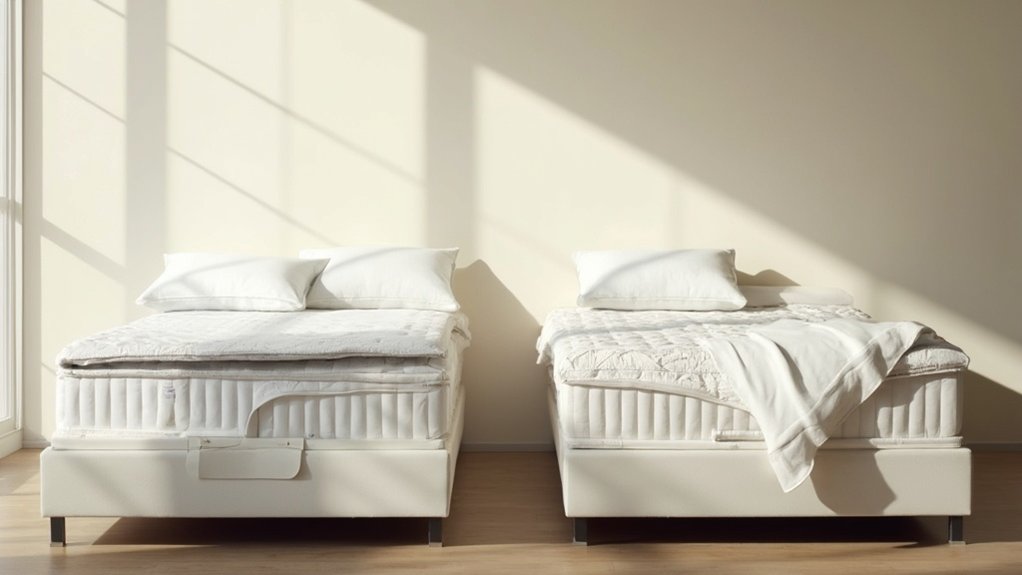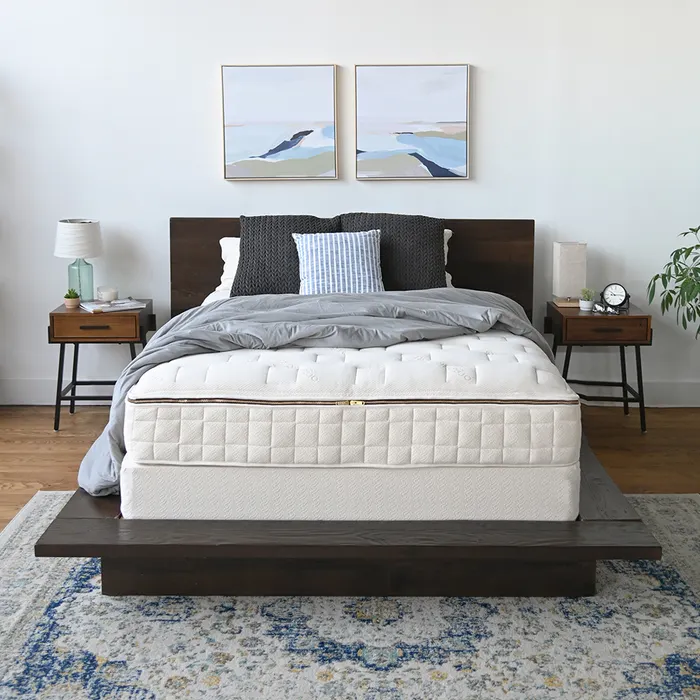Airpedic Vs Saatva
When choosing between Airpedic and Saatva, you’ll find two distinct premium mattress approaches. Airpedic specializes in customizable air chamber technology with prices ranging from $1,599 to $5,999, while Saatva offers luxury hybrid coil construction starting at $1,395. Both brands provide financing options and extensive trial periods, but they differ in their core technologies. Airpedic focuses on adjustable comfort with their five-layer design and Kool-Flow® technology, whereas Saatva’s coil-on-coil system delivers traditional luxury support with modern innovations. Their warranties also vary considerably – Airpedic offers 20 years while Saatva provides 365 days to test their mattresses. Understanding each brand’s unique features will help guide your investment decision.
Company Overview and History
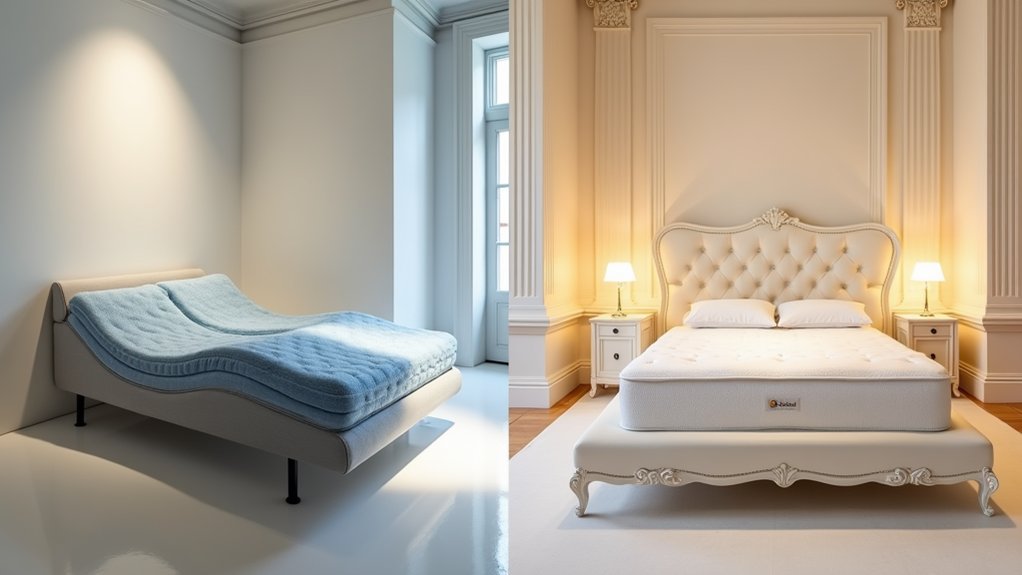
Two pioneers in the mattress industry, Air-Pedic and Saatva emerged during the early 2010s with distinct approaches to revolutionizing sleep comfort.
Saatva, founded in 2010 by Ron Rudzin and his co-founders, established itself as an early innovator in the online luxury mattress market before competitors like Casper and Purple entered the scene.
>>SAATVA MATTRESS 20% OFF CLICK HERE<<
Air-Pedic followed in 2014, launching their specialized air-based mattress technology from their headquarters in Westlake Village, California. While they’ve maintained a focused approach on air mattress innovation, Saatva began with luxury innerspring mattresses and expanded their lineup through the years. The concept of adjustable air mattresses dates back to the 19th century innovations when companies like Mechanical Mfg. Co. first marketed them.
The companies’ leadership structures reflect their different approaches to the market. Saatva benefits from the extensive experience of Ron Rudzin, who brings over 30 years of furniture and bedding expertise, along with tech-savvy co-founders who’ve helped shape their e-commerce strategy.
Air-Pedic, while not highlighting specific executives, has built its reputation on product specialization and customer support.
Both companies operate primarily through direct-to-consumer models, though Saatva distinguishes itself with white-glove delivery service and a three-month trial period, while Air-Pedic focuses on phone and website support for their specialized air mattress systems.
Price Range and Payment Options
While both companies have built strong foundations in the mattress industry, their pricing strategies reflect their distinct market positions.
You’ll find Airpedic’s range starts at $1,599 for basic models and extends up to $5,999 for premium options, while Saatva’s Classic line ranges from $1,395 to $2,595, with their Solaire collection reaching $4,294 for a Cal King. Like the Solaire, Sleep Number mattresses offer multiple firmness options for customized comfort.
When it comes to payment flexibility, both manufacturers offer attractive financing solutions.
Airpedic provides 0% APR financing over 12 months with monthly payments as low as $55, making their luxury mattresses more accessible. Similarly, Saatva partners with Klarna to offer 12-month installment plans starting at $67 monthly, with no down payment required.
You’ll notice Saatva’s more aggressive approach to discounts, particularly during major sales events like Black Friday, where you can find tiered money-off promotions and 12-15% discounts off MSRP.
Airpedic, however, maintains a more consistent pricing structure, focusing on the inherent value of their products rather than promotional offers.
Both brands’ financing options help you manage costs while accessing high-quality sleep solutions.
Mattress Construction and Materials
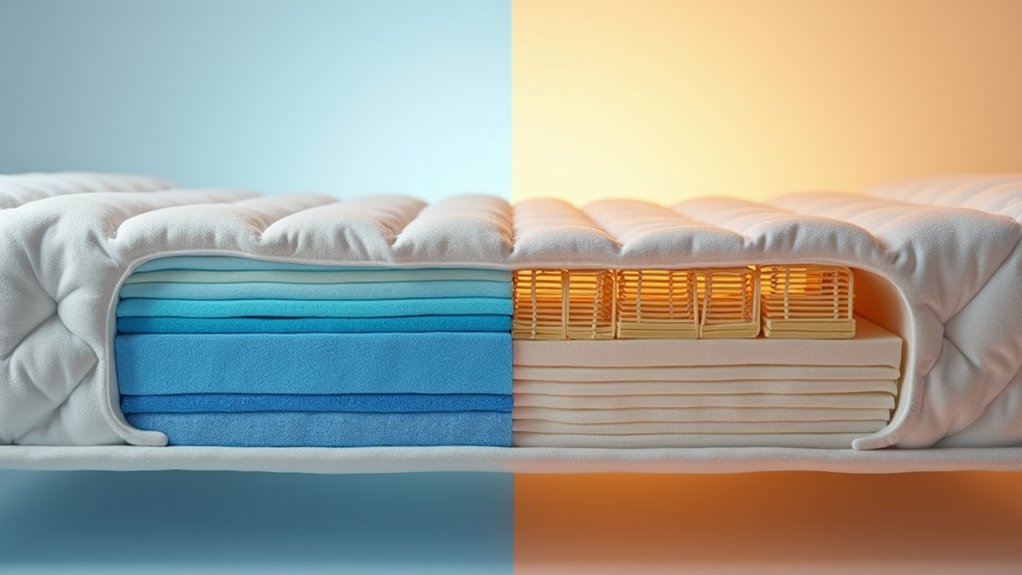
The Airpedic 1100 features five comfort layers for optimal support and pressure relief.
Cooling Technology
In the domain of cooling technology, Airpedic and Saatva take distinctly different approaches to temperature regulation.
Airpedic relies on its Airflow Transfer System, which actively moves body heat away through strategically placed holes and channels throughout the mattress. The tri-layer design enhances breathability for optimal temperature control. You’ll find their Hypergel Infusion layer working alongside a 2-inch gel-infused foam to maintain ideal temperature.
Saatva’s approach centers on its coil-on-coil construction, creating natural airflow pathways that have proven effective in thermal gun tests, showing only a 9.3-degree Fahrenheit increase after 5 minutes.
Their CoolVent System utilizes phase change materials to absorb and disperse excess body heat.
Both manufacturers incorporate specialized cooling elements into their designs.
Airpedic uses medical-grade air chambers and Kool-Flow® Micro-vented Bamboo Cover, while Saatva features natural latex and moisture-wicking New Zealand wool in specific models.
You’ll notice Airpedic’s system focuses on active cooling through engineered airflow, whereas Saatva combines passive cooling properties of natural materials with strategic air circulation through their coil system.
Sleeping Position Support
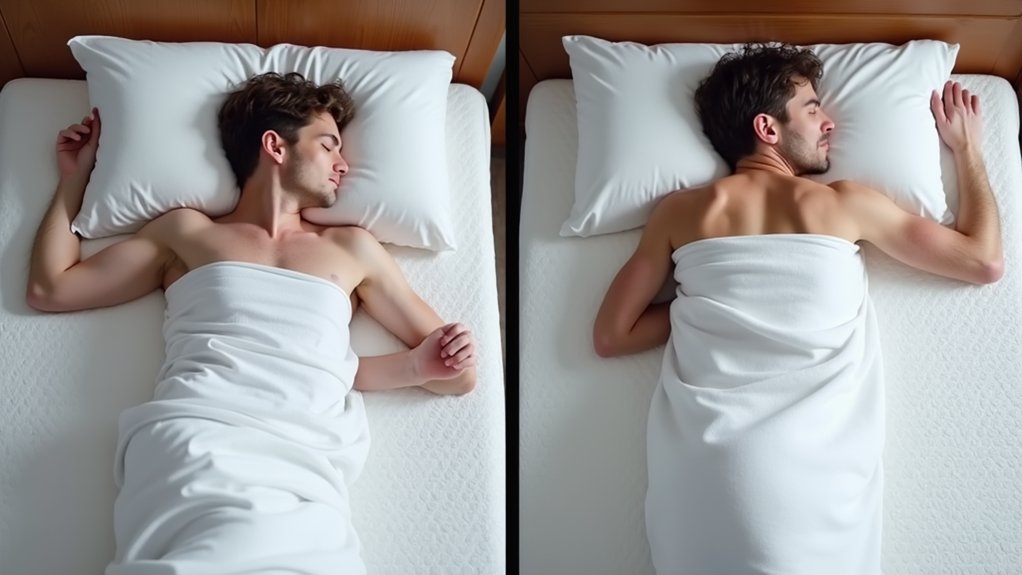
Beyond temperature management, sleep position compatibility stands out as a key differentiating factor between these mattresses.
Saatva’s lineup offers specialized support for every sleep position through their varied models and firmness levels.
The comfort layer scores between 2.5-4.5 provide optimal cushioning across different positions.
If you’re a back sleeper, you’ll find excellent support in the Saatva Classic’s Firm or Luxury Firm options, which maintain proper spinal alignment.
The Latex Hybrid and HD models also deliver the necessary structure for back sleeping.
Side sleepers should consider the Plush Soft version of the Saatva Classic or the Memory Foam Hybrid, as these provide adequate pressure relief for hips and shoulders.
The Loom & Leaf’s Relaxed Firm option specifically caters to side sleeping needs.
For stomach sleepers, Saatva’s firmer options prevent excessive sinking, with the Classic Firm and HD models offering ideal support.
The mattresses’ zoned support system helps maintain proper spinal positioning.
Combination sleepers will appreciate the versatility of the Luxury Firm Classic or the Latex Hybrid.
For maximum adaptability, the Solaire’s 50 firmness settings let you adjust the support level as your sleep positions change throughout the night.
Pressure Relief Features
When it comes to pressure relief, Saatva’s mattresses excel through their innovative combination of materials and design features.
You’ll find 4.5″ of comfort material, which exceeds the industry average by 0.4″, delivering exceptional pressure point reduction with a max PSI of just 1.31.
The mattresses incorporate multiple pressure-relieving technologies, including foam-encased pocketed coils and a plush Euro pillowtop cover. The organic cotton cover enhances comfort while providing antimicrobial protection with Guardin™ treatment.
You’ll benefit from the Therapeutic Support Core™, which automatically adjusts to your body’s movements, while triple-tempered recycled steel springs work with specialized foam modules for ideal contouring.
For targeted relief, Saatva offers specialized models like the Saatva Rx, designed specifically for chronic back and joint conditions.
The Memory Foam Hybrid features gel-infused and AirCradle memory foam layers, while the HD model combines latex, poly foam, and memory foam with steel coils for thorough support.
Temperature regulation hasn’t been overlooked in the pressure relief design.
You’ll stay cool thanks to graphite-infused foam, phase-change materials, and natural latex layers that promote airflow while maintaining ideal pressure distribution throughout the night.
Motion Isolation Performance
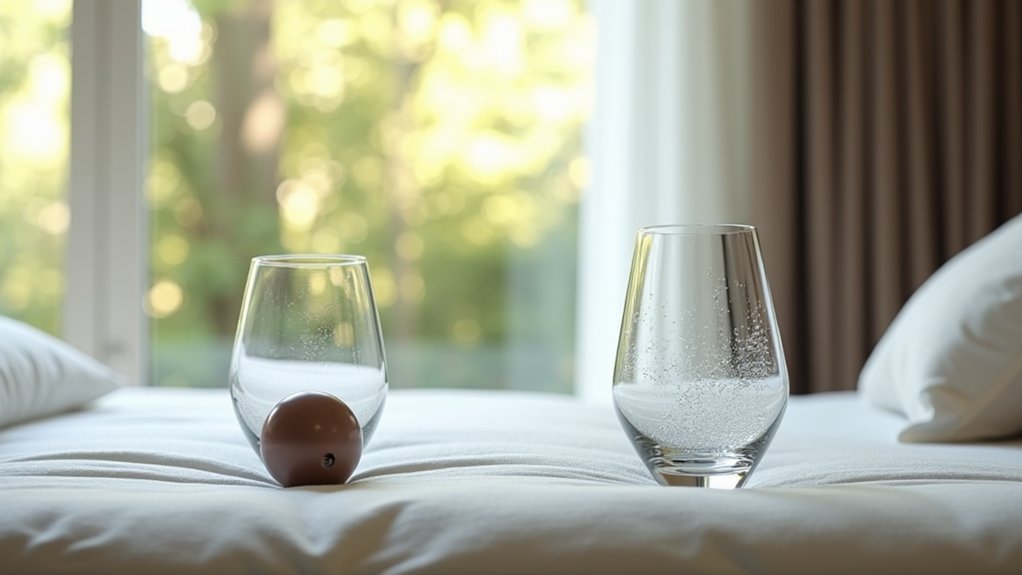
Most sleepers will notice significant differences between Airpedic and Saatva’s motion isolation capabilities.
When you’re comparing these brands, you’ll find that Saatva’s performance varies considerably across their mattress lineup.
The Saatva Classic demonstrates impressive motion isolation for a hybrid, particularly during specialized testing with a 10-pound weight drop. You won’t see much movement in wine glass tests, indicating good motion control for couples. The mattress features individually wrapped coils that help minimize motion transfer between sleeping partners.
However, the Saatva Latex Hybrid doesn’t perform as well, with higher motion transfer that might disturb light sleepers.
If you’re shopping with motion isolation as a priority, you’ll want to take into account these key factors:
- The Classic model outperforms other Saatva options
- Innerspring models score around 3/5 for motion isolation
- Interconnected coils transfer more movement than pocketed designs
You can enhance motion isolation in any Saatva model by:
- Adding a memory foam mattress topper
- Choosing a split king configuration
- Opting for models with thicker comfort layers
These modifications can help compensate for the inherent motion transfer characteristics of Saatva’s coil-based designs.
Edge Support Analysis
Edge support stands out as a clear differentiator between Airpedic and Saatva mattresses. When you’re comparing these two options, Saatva’s edge support capabilities are thoroughly documented and impressive, while Airpedic’s edge support features aren’t well-documented.
With Saatva, you’ll experience exceptional edge stability thanks to its dual-coil construction and foam-encased border. The mattress shows minimal compression when sitting (3.0 inches compared to the industry average of 4.03 inches) and maintains strong support when you’re lying near the edge. The reinforced cording and dense foam along the perimeter enhance the mattress’s edge support performance.
You’ll find this particularly useful if you:
- Share your bed and need to use the full surface
- Sit on the edge while getting dressed
- Need support when getting in and out of bed
Airpedic’s multi-chamber air system focuses primarily on customizable comfort and spinal alignment. While it may provide adequate overall support, there’s no specific emphasis on edge reinforcement or specialized edge support features.
You won’t find detailed testing data or specific edge support metrics for Airpedic mattresses, making it difficult to make direct comparisons with Saatva’s documented performance.
Durability and Longevity
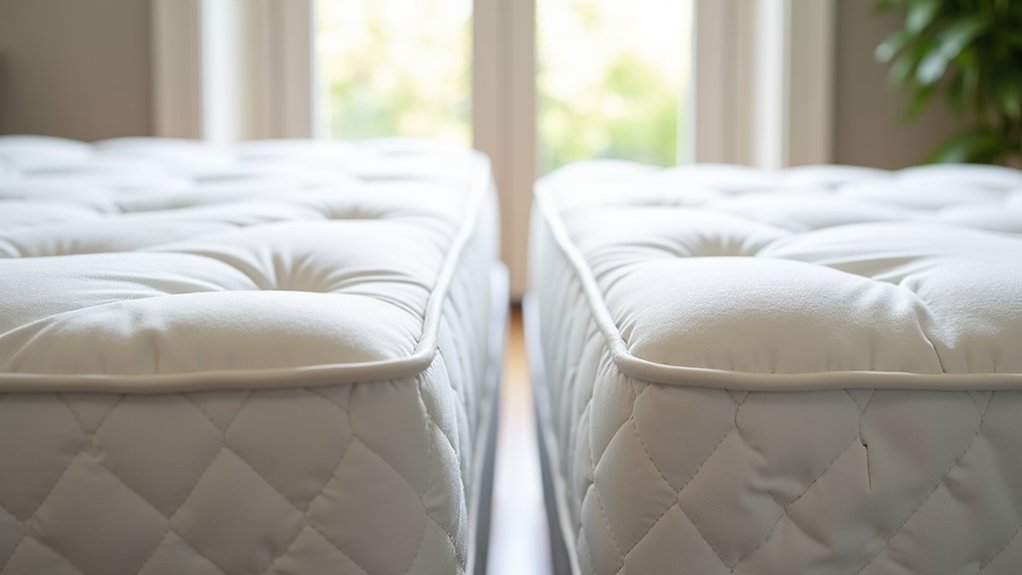
Durability emerges as a key strength for both Airpedic and Saatva mattresses, with each brand exceeding typical industry lifespans. While standard mattresses last 7-10 years, you’ll find both these options engineered for extended durability.
Airpedic’s construction features 100% urethane chambers with RF-welded seams, guaranteeing lasting structural integrity. The high-density materials and seamless center support contribute to the mattress’s impressive 20-year warranty coverage. The 15 mil thick walls ensure exceptional durability against air leakage.
You’ll also benefit from the strategically placed ventilation holes that help preserve the foam’s resilience.
Saatva’s dual-coil system provides exceptional longevity, particularly beneficial if you’re a heavier sleeper. The mattress’s construction prevents sagging, while the organic cotton pillow top maintains its shape since it’s never compressed for shipping.
The coil-on-coil design ensures consistent support throughout the mattress’s lifespan.
Key Durability Features:
- Airpedic’s hypoallergenic urethane resists bacteria and mold
- Saatva’s tufted construction maintains structural integrity
- CertiPUR-US® certified foam in Airpedic guarantees lasting quality
- Both brands utilize premium materials that maintain their properties over time
- Edge-to-edge support systems prevent premature wear
Warranty and Return Policies
Both Airpedic and Saatva offer thorough warranty and return policies, though they differ noticeably in their terms and conditions.
Airpedic provides a 120-night trial period with a mandatory 30-day break-in period and requires at least one comfort enhancement attempt. In contrast, Saatva offers a more generous 365-day trial for most mattresses, though you’ll pay a $99 processing fee for returns.
When it comes to warranties, Airpedic extends a 20-year limited warranty for mattresses and foundations, plus a 10-year warranty for air pumps. Their coverage becomes prorated after two years, and you’ll need to maintain the mattress in like-new condition. For warranty claims, customers must contact their customer service line at (800) 875-1973.
Saatva’s warranty terms vary by product but consistently cover manufacturing defects.
The return process differs noticeably between brands. You’ll need a return authorization from Airpedic, and freight costs aren’t refundable. Refunds can take up to 45 days after inspection.
With Saatva, you’ll simply call to schedule a pickup, and refunds process within 7-10 days.
Both companies require products to be undamaged and in good condition for returns, with neither covering comfort preference issues or improper use.
Conclusion
You’ll find both AirPedic and Saatva offer quality mattresses that adapt to your needs like a well-tailored suit. While AirPedic excels in customizable air support and medical-grade materials, Saatva delivers luxury hybrid comfort at a lower price point. Your choice depends on whether you prioritize adjustability and therapeutic benefits (AirPedic) or traditional luxury materials with proven coil support (Saatva). Consider your budget, sleeping style, and specific health needs when deciding.
